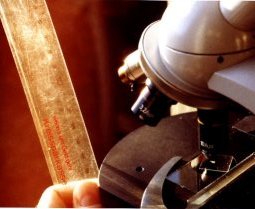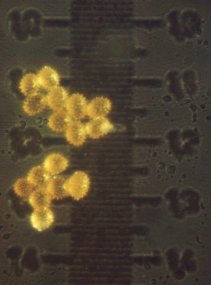|
2. Direct measuring method
|
With both eyes opened, view into eyepiece with one eye, and onto a ruler above the microscope stage with the other eye. The apparent object size in mm measured on the ruler's scale and divided by
the microscope's current total magnification yields the actual size to an accuracy of approx. 95%. The method requires some exercise but eliminates the need for a micrometer
mit dt - actual size,
ds - apparent size (in mm),
Vob - objective magnification,
Vok - eyepiece magnification,
Vges - total magnification
(conversion from mm to um by multiplying the figures with 1000)
Experiment: How big are pollen grains?
Material: Pollen, hair pencil, monocular microscope, ruler.
Realization: Place some pollen grains onto the specimen slide. Microscopize with remain open. Move the ruler in from the side until the images of a pollen grain and the ruler scale overlap. How many millimeters on the
scale correspond to the grain's size? Divide this figure by the microscope's total magnification to get the actual size.
Exercises:
a) Measure the pollen grain sizes of different plants in millimeters.
b) Convert the figures to micrometers (1000 um = 1 mm).
c) Draw pollen grains and dimensioning.


